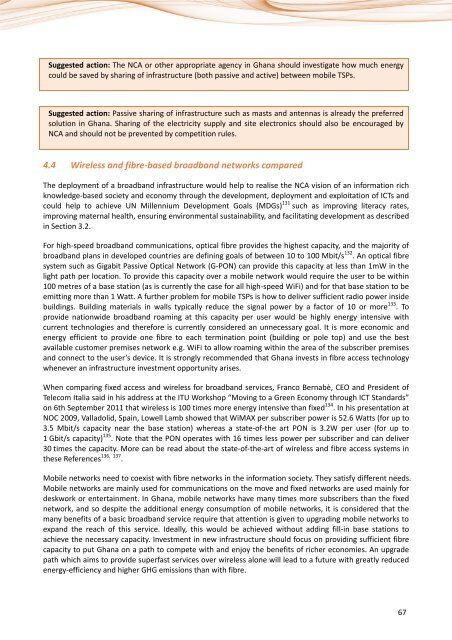Information and communication technologies (ICTs) and ... - ITU
Information and communication technologies (ICTs) and ... - ITU
Information and communication technologies (ICTs) and ... - ITU
You also want an ePaper? Increase the reach of your titles
YUMPU automatically turns print PDFs into web optimized ePapers that Google loves.
Suggested action: The NCA or other appropriate agency in Ghana should investigate how much energy<br />
could be saved by sharing of infrastructure (both passive <strong>and</strong> active) between mobile TSPs.<br />
Suggested action: Passive sharing of infrastructure such as masts <strong>and</strong> antennas is already the preferred<br />
solution in Ghana. Sharing of the electricity supply <strong>and</strong> site electronics should also be encouraged by<br />
NCA <strong>and</strong> should not be prevented by competition rules.<br />
4.4 Wireless <strong>and</strong> fibre-based broadb<strong>and</strong> networks compared<br />
The deployment of a broadb<strong>and</strong> infrastructure would help to realise the NCA vision of an information rich<br />
knowledge-based society <strong>and</strong> economy through the development, deployment <strong>and</strong> exploitation of <strong>ICTs</strong> <strong>and</strong><br />
could help to achieve UN Millennium Development Goals (MDGs) 131 such as improving literacy rates,<br />
improving maternal health, ensuring environmental sustainability, <strong>and</strong> facilitating development as described<br />
in Section 3.2.<br />
For high-speed broadb<strong>and</strong> <strong>communication</strong>s, optical fibre provides the highest capacity, <strong>and</strong> the majority of<br />
broadb<strong>and</strong> plans in developed countries are defining goals of between 10 to 100 Mbit/s 132 . An optical fibre<br />
system such as Gigabit Passive Optical Network (G-PON) can provide this capacity at less than 1mW in the<br />
light path per location. To provide this capacity over a mobile network would require the user to be within<br />
100 metres of a base station (as is currently the case for all high-speed WiFi) <strong>and</strong> for that base station to be<br />
emitting more than 1 Watt. A further problem for mobile TSPs is how to deliver sufficient radio power inside<br />
buildings. Building materials in walls typically reduce the signal power by a factor of 10 or more 133 . To<br />
provide nationwide broadb<strong>and</strong> roaming at this capacity per user would be highly energy intensive with<br />
current <strong>technologies</strong> <strong>and</strong> therefore is currently considered an unnecessary goal. It is more economic <strong>and</strong><br />
energy efficient to provide one fibre to each termination point (building or pole top) <strong>and</strong> use the best<br />
available customer premises network e.g. WiFi to allow roaming within the area of the subscriber premises<br />
<strong>and</strong> connect to the user’s device. It is strongly recommended that Ghana invests in fibre access technology<br />
whenever an infrastructure investment opportunity arises.<br />
When comparing fixed access <strong>and</strong> wireless for broadb<strong>and</strong> services, Franco Bernabè, CEO <strong>and</strong> President of<br />
Telecom Italia said in his address at the <strong>ITU</strong> Workshop “Moving to a Green Economy through ICT St<strong>and</strong>ards”<br />
on 6th September 2011 that wireless is 100 times more energy intensive than fixed 134 . In his presentation at<br />
NOC 2009, Valladolid, Spain, Lowell Lamb showed that WiMAX per subscriber power is 52.6 Watts (for up to<br />
3.5 Mbit/s capacity near the base station) whereas a state-of-the art PON is 3.2W per user (for up to<br />
1 Gbit/s capacity) 135 . Note that the PON operates with 16 times less power per subscriber <strong>and</strong> can deliver<br />
30 times the capacity. More can be read about the state-of-the-art of wireless <strong>and</strong> fibre access systems in<br />
these References 136, 137 .<br />
Mobile networks need to coexist with fibre networks in the information society. They satisfy different needs.<br />
Mobile networks are mainly used for <strong>communication</strong>s on the move <strong>and</strong> fixed networks are used mainly for<br />
deskwork or entertainment. In Ghana, mobile networks have many times more subscribers than the fixed<br />
network, <strong>and</strong> so despite the additional energy consumption of mobile networks, it is considered that the<br />
many benefits of a basic broadb<strong>and</strong> service require that attention is given to upgrading mobile networks to<br />
exp<strong>and</strong> the reach of this service. Ideally, this would be achieved without adding fill-in base stations to<br />
achieve the necessary capacity. Investment in new infrastructure should focus on providing sufficient fibre<br />
capacity to put Ghana on a path to compete with <strong>and</strong> enjoy the benefits of richer economies. An upgrade<br />
path which aims to provide superfast services over wireless alone will lead to a future with greatly reduced<br />
energy-efficiency <strong>and</strong> higher GHG emissions than with fibre.<br />
67

















